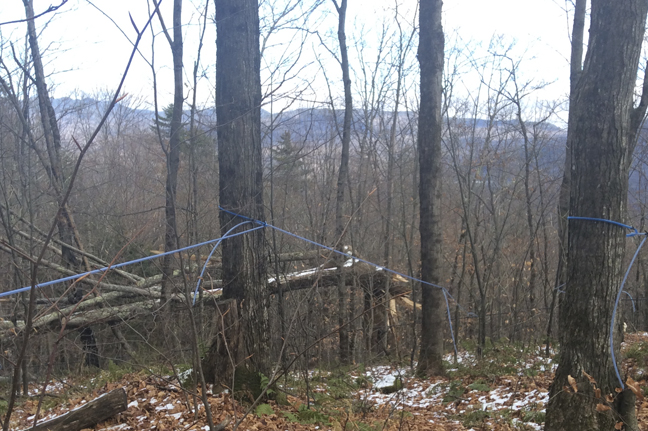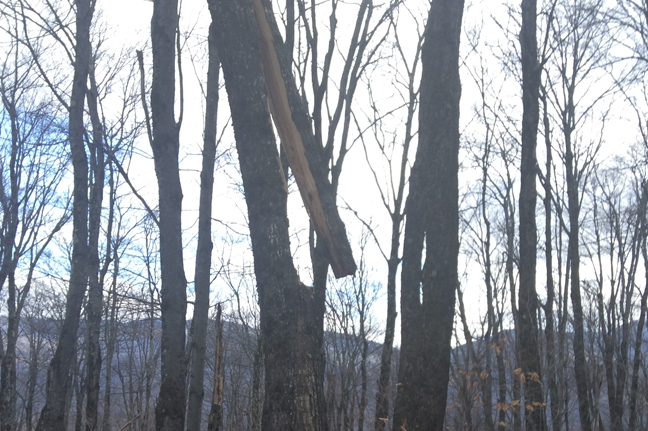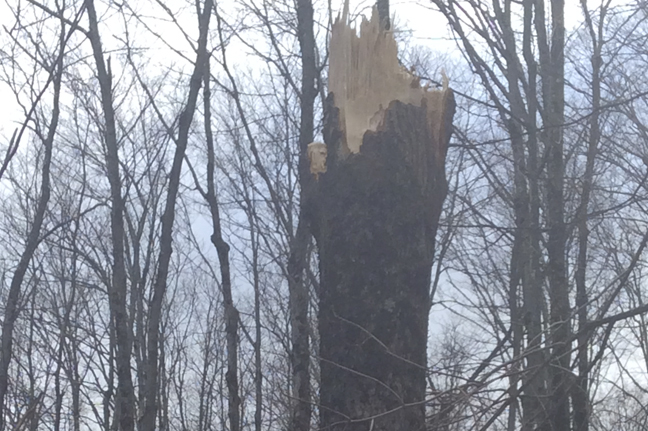Headlines
Late October storm pounded Vermont sugarmakers
'We’ve lost a lot of taps and a lot of trees,' one producer says
By PAUL POST | DEC. 21, 2017
Bob White says some parts of his property looks like it was used for an Air Force bombing range.
A half-mile away, Dave Davis thought a locomotive was coming through his house, which shook violently from sustained high winds that reached up to 80 mph.
They're among the scores of northern Vermont maple producers still digging out, clearing away downed trees, and trying to assess damage from a severe storm that ripped through their area the night of Sunday, Oct. 29.
”Everybody in my area got punched pretty hard,” said White, owner of Cowie Mountain Maple in Underhill, northeast of Burlington. ”To be honest, I dont even know if were going to have a season. Theres nothing left.”
By mid-November, he had only managed to clear one of his eight tubing mainlines. Power was restored, after going without it for a full week. But many utility lines were still hanging low as crews were overwhelmed by the extent of damage.
“It took them six hours to reach my sugarhouse on Cowie Road,” White said. ”One hundred percent of the power line was on the road.”
Thousands of tall trees, including many popple and pine, were ripped up by their roots while others snapped off 20 feet high, creating dangerous situations for people trying to clear them away.
“If you can carefully cut the tree out you can save the tubing,” White said. ”The biggest trees that fell got lodged in other trees. Every storm hurts, but this did more damage than most I’ve seen.”
He expects cleanup costs to be in the neighborhood of $30,000.
Compounding problems, White also runs a busy Christmas tree farm, which demands his full attention at this time of year. So it’s been difficult to get in the woods for cleanup duties. For once, he’d almost rather not have a white Christmas, as early snow would make the job even harder.
However, White refuses to get down about things as he takes what Mother Nature deals him in stride.
“Like anything in agriculture, you take risks,” he said. ”Do the best you can, pick your feet up and keep going. Do the best you can with what you’ve got.”
Davis owns Maple Crest Farm, also in Underhill. He normally sets 16,000 taps, but expects to be down at least 2,000 this year.
”We’ve lost a lot of taps and a lot of trees,” he said. “One section we probably wont even try to tap. Everything’s laying on the ground.”
Dave Folino owns Hillsboro Sugarworks in Starksboro, Addison County, southeast of Burlington. He unequivocally said the Oct. 29-30 storm was the worst hes seen during his 40 years of making maple.
”Because of the timing, near Halloween, a lot of the poplars still had leaves on them,” he said. ”When they fell, they knocked over everything. I dont have another job, so I’ve gotten quite a bit cleaned up. A lot of producers dont know the extent of damage because they havent been out in the woods as much. They’re going to find, when they go acre by acre, that it’s worse than they thought.”
After 11 straights days of solid cleanup, Folinos wife asked him, ”How’s it going?”
“I’m 90 percent done,” he said.
A couple of days later, she asked again, “How much have you got done now?”
“80 percent,” Folino said.
Quite simply, the more he did, the more he found.
Folino urged fellow producers to use their time wisely, and devote whatever hours they can to clearing downed trees and limbs. ”Most sugarmakers are also deer hunters,” he said. ”A month from now, a branch laying on tubing they could have removed easily, might be under a foot of snow. If they go hunting, they’re making a choice they might regret later.”
The combined impact of lost production could be significant. However, there’s not even the slightest risk of Vermont losing its status as the nations number one maple producer, said Mark Isselhardt, maple specialist at the University of Vermont Extension Proctor Maple Research Center.
”The damage seemed more focused in the central and northern parts of the state,” he said. ”It will likely turn out to be spotty, with some isolated areas of dramatic damage and lost production. It’s not very comforting for the unlucky producers where the impact may be severe, but overall I think the total impact will be minor.”
Isselhardt is more concerned about the safety of people working in the woods, trying to clear away downed trees and limbs.
”Sometimes it was non-maple trees that snapped or blew over and took out crop trees,” he said. ”The trees that did come down appeared to be mostly poplars, which still had leaves, and conifers such as white pine. Some sugarbushes have areas yet to be inventoried.”
“I hope producers remember that there can be a tremendous amount of tension on these trees and mainlines,” Isselhardt said. Taking time, wearing safety gear and cutting carefully will be important to keep folks safe.
Davis said Farm Service Agency officials have surveyed his property with hopes of obtaining federal disaster aid to offset considerable cleanup costs. However, the U.S. has had so many recent natural disasters -- hurricanes ravaging Texas and Florida, and massive Western wildfires -- that funds might be hard to come by.
Davis said he’s keeping track of all expenses such as tubing repairs, along with chainsaw and skidder work done during cleanup. This will make it easier to get reimbursed if and when financial help becomes available, he said.
The Vermont Agency of Agriculture, Food & Markets urges farmers seeking financial recovery assistance to apply for emergency loans as soon as possible.
The Vermont Farm Fund, a program of the Center for an Agricultural Economy, offers an emergency loan program to help farmers recover from natural disasters. The program currently has around $70,000 in available funding. The maximum loan amount is $10,000 with zero interest, payable over 24 months.
Once an application is submitted, most emergency loan requests are approved within 14 business days. To apply, see: https://www.vermontfarmfund.org/how-to-apply/.
For additional information about the Vermont Farm Fund program visit www.VermontFarmFund.org, or contact the VFF Program Manager, Kate Stephenson, at Kate@vermontfarmfund.org.
The Agency of Agriculture continues to encourage farmers to document any losses from the recent storm. Its helpful to take pictures and keep detailed records. This information could be valuable for farmers, state and federal officials as they calculate the economic impact of this wind storm.


































